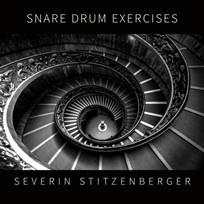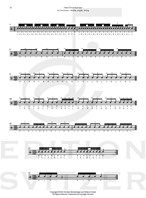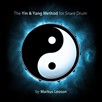
Snare Drum Exercises
Composer: Severin Stitzenberger
Instrument: Snare Drum Method Book
Level: Advanced
Published: 2021
Price: €25.00
Item details
-
Description +
-
Preface
In this booklet I join all exercises I wrote for the percussion students of HMT Leipzig during the difficult times of Corona 2020. Due to the lockdowns we spent a lot of time in online classes working on these exercises, which we performed on the pad or the snare drum. We had a nice time and a good learning process. So I think this is worth to get collected all at once in a small booklet.
For developing strength and velocity I highly recommend to not play these exercises too often in a row. Especially in cases of velocity and accuracy we want to trigger the fast and explosive white muscle fibers and not the slow-twitch red ones which are more for endurance. This you will also recognize in several exercises where I tried to build in a strong and fast triggering playing section followed by a small recovery section. The muscles are supposed to be allowed to recover while playing. (e.g. Chapter 11 Ex.10)
In some exercises I implemented two different sections. First a template section where I want to create a sound structure which you have to keep up and monitor in the second confirmation section. A good example for these kind of exercises is number two to four in chapter 2 "Doubles".
At the places where I have indicated to strike both hands at once (RL / LR / "double stop"), I want to work and improve equality and smoothness of the single strokes. If you can’t hear flams in the double stops it is a good sign that your singles will sound even.
The first exercise in chapter four "Rolls" is (for me) the most important exercise to develop a smooth, equal and versatile way of rolling. This exercise requires a huge amount work and time dedication. I recommend to start this exercise in pp at tempo 60 and then slowly rise speed and dynamic till you reach ff at tempo 180.
Taking a close look at the requirements of our application area - the orchestra - it is of additional importance that we concentrate on perfecting the quality of playing short phrases. Here, it is important that the beginning of the phrase is on the money and we get the absolute right tempo and expression already at the very beginning of each phrase. I therefore think that it is necessary to practice this more often. That’s why I tent to practice more in short cycles. I also added some exercises that might feel a bit strange and where I intended to focus and train the "to be on point" qualities here.
To keep up with the application in the orchestral context I added exercises for dynamic changes as well as for different sound colors. This is what needs to be built in to the every day practice and what will eventually make a very versatile player. It is of great importance to evolve a sense for this kind of colorful drumming and to get your hands and ears familiarized.
The exercises are organized in eleven chapters with individual technical exercises depending on the topic. In between I added so called "conclusions and warm up routines". This is meant to be a summary of the previous chapters and could be played after having worked on the exercises before to remember the special issues. Also to be used as warm-up program for special occasions.
If there are two lines of sticking indicated the second line is the sticking of the repeat.
Severin Stitzenberger
Leipzig, in December 2020
„I owe a huge debt of thanks to my teachers Gerolf Stitzenberger, Uwe Eichele, Andy Witte, Peter Sadlo, Arnold Riedhammer and Klaus Schwärzler for sharing their knowledge and passion; to Muriel Razavi, Johann-Georg Baumgärtel and Edzard Locher for lending me their critical eyes and keen minds; to Johan Svitzer for the very nice contact and the uncomplicated realization of this project and especially to my wife Andrea for having my back since ever.“
-
-
Instrumentation +
-
Snare Drum Method Book
-
-
About the composer +
-
Severin Stitzenberger, born and raised in Wangen im Allgäu (Germany), is 1st percussionist of the Gewandhausorchester zu Leipzig and member of the brass ensemble Salaputia Brass. Since 2018 he has been teaching at the Hochschule für Musik und Theater Felix Mendelssohn Bartholdy Leipzig.
-
-
Reviews +
-
Review (Percussive Notes, February 2022)
Snare Drum Exercises by German percussionist Severin Stitzenberger is an excellent and unique approach specifically devised for orchestral/ classical snare drum technique. At first glance, the material appears deceptively simple as a series of single and double strokes with accents, flams, and other grace notes. However, this material is designed specifically for contexts that classical snare drummers must perform in with emphasis not only on technique, but time/rhythm, dynamics, articulation, speed, and execution.
Orchestral snare drummers must execute highly demanding passages, often entering intricate pieces of music for performances in short durations. This book prepares students for such demands. The single- and double-stroke section isn’t the typical material based on repetitive practice. Instead, the material has passages with liberal use of rests where the execution of the material is practiced much in the way of the demands in a classical music performance context for the percussionist. The next section on timing makes use of a metronome for the intricate and interesting mixed rhythmic material that must be performed with a click individually on each of the four subdivisions of sixteenth notes. The book continues with sections on rolls (closed and open), flams, accents, and material with dynamics.
Stitzenberger has outdone himself with the inventiveness of this pedagogical material so much so that I cannot recommend it highly enough. This book is sure to become a classic and staple methodology for teachers and students in formal music programs. Bravo!
—N. Scott Robinson
___________
Review (Percussive Notes, June 2022)
The Covid pandemic caused many percussion educators to alter their curriculum. Hand technique was easily addressed during online lessons. Severin Stitzenberger wrote a number of technique exercises to use online with his students at HMT Leipzig. Those exercises were compiled to form this book.
The first lessons address single and double strokes. Unison strokes are also utilized to ensure a uniform motion and consistent sound. The section on rhythmic timing will challenge the performer to play both binary and ternary rhythms with extreme precision. Rolls are presented in both a buzz- and double-stroke format. Embellishments such as flams, drags, ruffs, and accents are also a focus of study. The accented exercises include arrows, indicating the direction of the strokes. A challenging section on dynamics is included, utilizing dynamic markings as well as crescendos and decrescendos.
A study of diddle rudiments includes paradiddles, flam paradiddles, double paradiddles, paradiddle-diddles, and inversions of paradiddles. Staccato and legato strokes are also addressed. The book also features exercises to strengthen the weaker hand. A segment on speed is included, where the author recommends playing a short number of repetitions to train the fast twitch muscles.
The exercises within the book challenge all aspects of hand technique. The exercises were originally created for use during the pandemic, but the book’s topics will continue to remain relevant.
—Jeff W. Johnson
-
-
Credits +
-
Front Cover graphics and layout: Nicola Lee
Photo: Alexander Frank
Engraving: CPH Engraving
Printed in Copenhagen, Denmark
Copyright © Edition SVITZER
www.editionsvitzer.com
-





